
Euglenozoa are a large group of flagellate Discoba. They include a variety of common free-living species, as well as a few important parasites, some of which infect humans. Euglenozoa are represented by four major groups, i.e., Kinetoplastea, Diplonemea, Euglenida, and Symbiontida. Euglenozoa are unicellular, mostly around 15–40 μm (0.00059–0.00157 in) in size, although some euglenids get up to 500 μm (0.020 in) long.
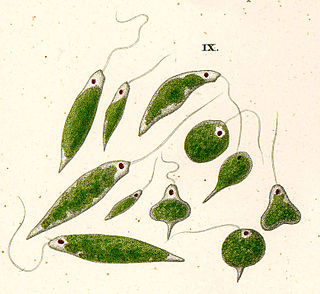
Euglenids or euglenoids are one of the best-known groups of flagellates. They are excavate eukaryotes of the phylum Euglenophyta, classified as class Euglenida or Euglenoidea. Euglenids are commonly found in freshwater, especially when it is rich in organic materials, with a few marine and endosymbiotic members. Many euglenids feed by phagocytosis, or strictly by diffusion. A monophyletic group known as Euglenophyceae have chloroplasts and produce their own food through photosynthesis. This group is known to contain the carbohydrate paramylon.

Kinetoplastida is a group of flagellated protists belonging to the phylum Euglenozoa, and characterised by the presence of a distinctive organelle called the kinetoplast, a granule containing a large mass of DNA. The group includes a number of parasites responsible for serious diseases in humans and other animals, as well as various forms found in soil and aquatic environments. The organisms are commonly referred to as "kinetoplastids" or "kinetoplasts".

Euglenophyceae (ICBN) or Euglenea (ICZN) is a group of single-celled algae belonging to the phylum Euglenozoa. They have chloroplasts originated from an event of secondary endosymbiosis with a green alga. They are distinguished from other algae by the presence of paramylon as a storage product and three membranes surrounding each chloroplast.

Bodo saltans is a free-living nonparasitic species of kinetoplastid flagellated phagotrophic protozoa that feed on bacteria. Bodo saltans cells have been reported in freshwater and marine environments.

Euglenales is an order of flagellates in the phylum Euglenozoa. The family includes the most well-known euglenoid genus, Euglena, as well as other common genera like Phacus and Lepocinclis.

Malawimonadidae is a family of unicellular eukaryotes of outsize importance in understanding eukaryote phylogeny.
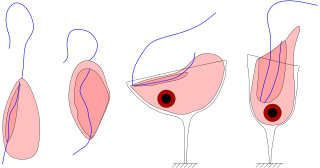
Jakobids are an order of free-living, heterotrophic, flagellar eukaryotes in the supergroup Excavata. They are small, and can be found in aerobic and anaerobic environments. The order Jakobida, believed to be monophyletic, consists of only twenty species at present, and was classified as a group in 1993. There is ongoing research into the mitochondrial genomes of jakobids, which are unusually large and bacteria-like, evidence that jakobids may be important to the evolutionary history of eukaryotes.

The kathablepharids or katablepharids are a group of heterotrophic flagellates closely related to cryptomonads. First described by Heinrich Leonhards Skuja in 1939, kathablepharids were named after the genus Kathablepharis. This genus is corrected to Katablepharis under botanical nomenclature, but the original spelling is maintained under zoological nomenclature. They are single-celled protists with two anteriorly directed flagella, an anterior cytostome for ingesting eukaryotic prey, and a sheath that covers the cell membrane. They have extrusomes known as ejectisomes, as well as tubular mitochondrial cristae.

Peranema is a genus of free-living phagotrophic euglenids. There are more than 20 nominal species, varying in size between 8 and 200 micrometers. Peranema cells are gliding flagellates found in freshwater lakes, ponds and ditches, and are often abundant at the bottom of stagnant pools rich in decaying organic material. Although they belong to the class Euglenoidea, and are morphologically similar to the green Euglena, Peranema have no chloroplasts, and do not conduct autotrophy. Instead, they capture live prey, such as yeast, bacteria and other flagellates, consuming them with the help of a rigid feeding apparatus called a "rod-organ." Unlike the green euglenids, they lack both an eyespot (stigma), and the paraflagellar body (photoreceptor) that is normally coupled with that organelle. However, while Peranema lack a localized photoreceptor, they do possess the light-sensitive protein rhodopsin, and respond to changes in light with a characteristic "curling behaviour."

Diplonema is a genus of free-living organisms in the Euglenozoa. They are distinguished from Rhynchopus in Class Diplonemea by the absence of a fully flagellate dispersive stage.

Neobodo are diverse protists belonging to the eukaryotic supergroup Excavata. They are Kinetoplastids in the subclass Bodonidae. They are small, free-living, heterotrophic flagellates with two flagella of unequal length used to create a propulsive current for feeding. As members of Kinetoplastids, they have an evident kinetoplast There was much confusion and debate within the class Kinetoplastid and subclass Bodonidae regarding the classification of the organism, but finally the new genera Neobodo was proposed by Keith Vickerman. Although they are one of the most common flagellates found in freshwater, they are also able to tolerate saltwater Their ability to alternate between both marine and freshwater environments in many parts of the world give them a “cosmopolitan” character. Due to their relatively microscopic size ranging between 4–12 microns, they are further distinguished as heterotrophic nanoflagellates. This small size ratio limits them as bacterivores that swim around feeding on bacteria attached to surfaces or in aggregates.
Postgaardia is a proposed basal clade of flagellate Euglenozoa, following Thomas Cavalier-Smith. As of April 2023, the Interim Register of Marine and Nonmarine Genera treats the group as a subphylum. A 2021 review of Euglenozoa places Cavalier-Smith's proposed members of Postgaardia in the class Symbiontida. As Euglenozoans may be basal eukaryotes, the Postgaardia may be key to studying the evolution of Eukaryotes, including the incorporation of eukaryotic traits such as the incorporation of alphaproteobacterial mitochondrial endosymbionts.
Bihospites is a genus of symbiontid euglenozoans characterized by the presence of two species of epibiotic bacteria on the cell surface. Bihospites cells are clear, biflagellated, and uninucleated, that range between 40–120 μm long and 15–30 μm wide. Bihospites, as well as other members of the symbiontids, are found in semi-anoxic to anoxic sediments in benthic marine environments. Each cell surface is covered by both rod-shaped and spherical-shaped epibiotic bacteria that may share a commensalistic or mutualistic relationship with Bihospites host cells. Bihospites cells are highly contractile and contain several morphological synapomorphies which are present in euglenozoans, however they also contain several unique morphological traits including a unique C-shaped feeding apparatus.
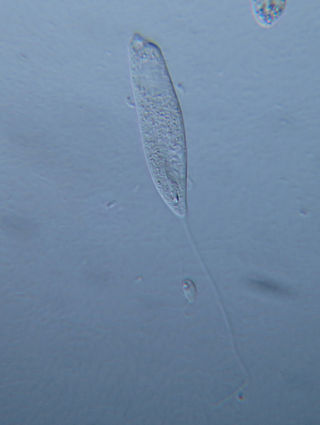
The peranemids are a group of phagotrophic flagellates, single-celled eukaryotes or protists. They belong to the Euglenida, a diverse lineage of flagellates that contains the closely related euglenophyte algae. Like these algae, peranemids have flexible cells capable of deformation or metaboly, and have one or two flagella in the anterior region of the cell. They are classified as family Peranemidae (ICZN) or Peranemataceae (ICBN) within the monotypic order Peranemida (ICZN) or Peranematales (ICBN).
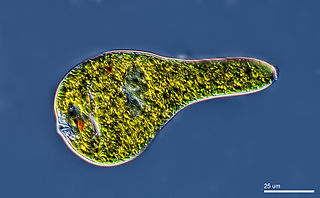
Spirocuta is a clade of euglenids, single-celled eukaryotes or protists belonging to the phylum Euglenozoa. They are distinguished from other euglenids by active deformation of their cell shape, a process called euglenid motion or metaboly. This is made possible by a high number of spirally arranged protein strips that run below their cell membrane and confer the cell with flexibility. These strips compose the helicoidal pellicle, a trait referenced by the alternative name Helicales.
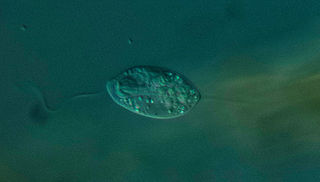
Anisonemia is a clade of single-celled protists belonging to the phylum Euglenozoa, relatives of the Euglenophyceae algae. They are flagellates, with two flagella for locomotion. Anisonemia includes various phagotrophic species and a group of primary osmotrophic protists known as Aphagea.

Rapaza viridis is a species of single-celled flagellate within the Euglenophyceae, a group of algae. It is the only species within the genus Rapaza, family Rapazidae and order Rapazida. It was discovered in a tide pool in British Columbia and described in 2012.
Eutreptiaceae (ICN) or Eutreptiidae (ICZN) is a family of algae in the class Euglenophyceae. It is the only family within the monotypic order Eutreptiales (ICN) or Eutreptiida (ICZN). It contains predominantly marine single-celled flagellates with photosynthetic chloroplasts.
Neometanema is a genus of phagotrophic flagellates belonging to the Euglenida, a diverse group of flagellates in the phylum Euglenozoa. It is the sole genus within the monotypic family Neometanemidae and suborder Metanemina. It composes the order Natomonadida together with a closely related clade of osmotrophs known as Aphagea.















